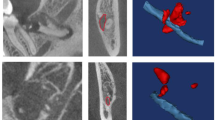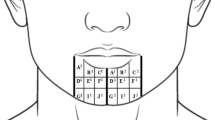Abstract
Purpose
This retrospective study investigated the relationship between the degree of neurosensory disturbance (NSD) and mandibular movement distance after sagittal split ramus osteotomy (SSRO) and assessed sensory recovery.
Methods
Lower lip hypoesthesia was evaluated at 1 week, 1 month, and 2 months after SSRO in 38 patients categorized according to the distance of mandibular movement: S group (0–7 mm; n = 17, 4 males and 13 females) and L group (7–14 mm; n = 21, 7 males, 14 females). Symptoms were evaluated by visual analog scale (VAS), tactile-threshold (SW) test, static 2-point discrimination (s-2PD) test, and current perception threshold (CPT) test.
Results
The two groups did not differ significantly in gender and age. The Aβ fiber results of the CPT test differed significantly between the groups at 1 week and 1 month postsurgery (P < 0.05). There were no significant differences between the groups throughout the period in terms of VAS, SW, s-2PD, Aδ fiber, and C fiber of CPT.
Conclusions
Post-SSRO, the incidence of NSD in terms of tactile sensation may be greater in the L group early postoperatively. This may assist surgeons in explaining postoperative hypoesthesia to patients preoperatively.




Similar content being viewed by others
References
Monnazzi MS, Real-Gabrielli MF, Passeri LA, Gabrielli MA (2012) Cutaneous sensibility impairment after mandibular sagittal split osteotomy: a prospective clinical study of the spontaneous recovery. J Oral Maxillofac Surg 70:696–702
Phillips C, Kim SH, Tucker M, Turvey TA (2010) Sensory retraining: burden in daily life related to altered sensation after orthognathic surgery, a randomized clinical trial. Orthod Craniofacial Res 13:169–178
Rustemeyer J, Eke Z, Bremerich A (2010) Perception of improvement after orthognathic surgery: the important variables affecting patient satisfaction. Oral Maxillofac Surg 14(3):155–162
Poort LJ, van Neck JW, van der Wal KG (2009) Sensory testing of inferior alveolar nerve injuries: a review of methods used in pro-spective studies. J Oral Maxillofac Surg 67:292–300
Werner JL, Omer GE Jr (1970) Evaluating cutaneous pressure sensation of the hand. Am J Occup Ther 24:347–356
Nogami K, Taniguchi S (2015) Stellate ganglion block compared with xenon light irradiation, is a more effective treatment of neurosensory deficits resulting from orthognathic surgery, as measured by current perception threshold. J Oral Maxillofac Surg 73(7):1267–1274
Verweij JP, Mensink G, Fiocco M, van Merkesteyn JP (2016) Incidence and recovery of neurosensory disturbances after bilateral sagittal split osteotomy in different age groups: a retrospective study of 263 patients. Int J Oral Maxillofac Surg 45(7):898–903
Teerijoki-Oksa T, Jääskeläinen S, Forssell K, Virtanen A, Forssell H (2003) An evaluation of clinical and electrophysiologic tests in nerve injury diagnosis after mandibular sagittal split osteotomy. Int J Oral Maxillofac Surg 32:15–23
Aizenbud D, Ciceu C, Hazan-Molina H, Abu-El-Naaj I (2011) Relationship between inferior alveolar nerve imaging and neurosensory impairment following bilateral sagittal split osteotomy in skeletal class III cases with mandibular prognathism. Int J Oral Maxillofac Surg 41:461–468
Colella G, Cannavale R, Vicidomini A, Lanza A (2007) Neurosensory disturbance of the inferior alveolar nerve after bilateral sagittal split osteotomy: a systematic review. J Oral Maxillofac Surg 65:1707–1715
van Merkesteyn JP, Zweers A, Corputty JE (2007) Neurosensory disturbances one year after bilateral sagittal split mandibular ramus osteotomy performed with separators. J Craniomaxillofac Surg 35:222–226
Rich J, Golden BA, Phillips C (2014) Systematic review of preoperative mandibular canal position as it relates to postoperative neurosensory disturbance following the sagittal split ramus osteotomy. Int J Oral Maxillofac Surg 43:1076–1081
Jones DL, Wolford LM, Hartog JM (1990) Comparison of methods to assess neourosensory alterations following orthognathic surgery. Int J Adult Orthodon Orthognath Surg 5:35–42
Takasaki Y, Noma H, Masaki H, Fujikawa M, Alberdas JL, Tamura H, Ueda E, Takaki T, Yamane G (1998) A clinical analysis of the recovery from sensory disturbance after sagittal splitting ramus osteotomy using a Semmes-Weinstein pressure aesthesiometer. Bull Tokyo Dent Coll 39:189–197
Westermark A, Bystedt H, von Konow L (1998) Inferior alveolar nerve function after mandibular osteotomies. Br J Maxillofac Surg 36:425–428
Westermark A, Bystedt H, von Konow L (1998) Inferior alveolar nerve function after sagittal split osteotomy of the mandible: correlation with degree of intraoperative nerve encounter and other variables in 496 operations. Br J Oral Maxillofac Surg 36:429–433
Dellon AL (1981) Evaliation of sensibility and reeducation of sensation in the hand, 1st edn. The Williams and Wilkins company, Boltimore, pp 3–192
Posnick JC, Zimbler AG, Grossman JA (1990) Normal cutaneous sensibility of the face. Plast Reconstr Surg 86:429–435
Cunningham LL, Tiner BD, Clark GM, Bays RA, Keeling SD, Rugh JD (1996) A comparison of questionnaire versus monofilament assessment of neurosensory deficit. J Oral Maxillofac Surg 54(4):454–459
Phillips C, Essick G, Zuniga J, Tucker M, Blakey G 3rd (2006) Qualitative descriptors used by patients following orthognathic surgery to portray altered sensation. J Oral Maxillofac Surg 64(12):1751–1760
Akal UK, Sayan NB, Aydoğan S, Yaman Z (2000) Evaluation of the neurosensory deficiencies of oral and maxillofacial region following surgery. Int J Oral Maxillofac Surg 29(5):331–336
Eliav E, Gracely RH, Nahlieli O, Benoliel R (2004) Quantitative sensory testing in trigeminal nerve damage assessment. J Orofac Pain 18(4):339–344
Jääskeläinen SK (2004) The utility of clinical neurophysiological and quantitative sensory testing for trigeminal neuropathy. J Orofac Pain 18(4):355–359
Kesarwani A, Antonyshyn O, Mackinnon SE, Gruss JS, Novak C, Kelly L (1989) Facial sensibility testing in the normal and posttraumatic population. Ann Plast Surg 22:416–425
Dellon AL, Andonian E, DeJesus RA (2007) Measuring sensibility of the trigeminal nerve. Plast Reconstr Surg 120(6):1546–1550
Kim HS, Kho HS, Kim YK, Lee SW, Chung SC (2000) Reliability and characterisitics of current perception thresholds in the territory of the infraorbital and inferior alveolar nerves. J Orofac Pain 14(4):286–292
Ziccardi VB, Hullett JS, Gomes J (2009) Physical neurosensory testing versus current perception threshold assessment in trigeminal nerve injuries related to dental treatment: a retrospective study. Quintessence Int 40(7):603–609
Calabria F, Sellek L, Gugole F, Trevisiol L, Bertolasi L, D’Agostino A (2013) The use of sensory action potential to evaluate inferior alveolar nerve damage after orthognathic surgery. J Craniofac Surg 24(2):514–517
Mensink G, Zweers A, Wolterbeek R, Dicker GG, Groot RH, van Merkesteyn RJ (2012) Neurosensory disturbances one year after bilateral sagittal split osteotomy of the mandibular performed with separators: a multi-centre prospective study. J Craniomaxillofac Surg 40:763–767
Borstlap WA, Stoelinga PJ, Hoppenreijs TJ, van’t Hof MA (2004) Stabilisation of sagittal split advancement osteotomies with miniplates: a prospective, multicentre study with two-year follow-up. Part I. Clinical parameters. Int J Oral Maxillofac Surg 33:433–441
Ylikontiola L, Kinnunen J, Oikarinen K (2000) Factors affecting neurosensory disturbance after mandibular bilateral sagittal split osteotomy. J Oral Maxillofac Surg 58:1234–1239
Van Sickels JE, Hatch JP, Dolce C, Bays RA, Rugh JD (2002) Effects of age, amount of advancement, and genioplasty on neurosensory disturbance after a bilateral sagittal split osteotomy. J Oral Maxillofac Surg 60:1012–1017
Joss CU, Vassalli IM (2009) Stability after bilateral sagittal split osteotomy advancement surgery with rigid internal fixation: a systematic review. J Oral Maxillofac Surg 67:301–313
Rempel D, Dahlin L, Lundborg G (1999) Pathophysiology of nerve compression syndromes: response of peripheral nerves to loading. J Bone Joint Surg am 81(11):1600–1610
Teerijoki-Oksa T, Jääskeläinen SK, Soukka T, Virtanen A, Forssell H (2011) Subjective sensory symptoms associated with axonal and demyelinating nerve injuries after mandibular sagittal split osteotomy. J Oral Maxillofac Surg 69(6):e208–e213
Kuroyanagi N, Miyachi H, Ochiai S, Kamiya N, Kanazawa T, Nagao T, Shimozato K (2013) Prediction of neurosensory alterations after sagittal split ramus osteotomy. Int J Oral Maxillofac Surg 42(7):814–822
Kobayashi A, Yoshimasu H, Kobayashi J, Amagasa T (2006) Neurosensory alteration in the lower lip and chin area after orthognathic surgery: bilateral sagittal split osteotomy versus inverted L ramus osteotomy. J Oral Maxillofac Surg 64:778
Gianni AB, D’Orto O, Biglioli F, Bozzetti A, Brusati R (2002) Neurosensory alterations of the inferior alveolar and mental nerve after genioplasty alone or associated with sagittal osteotomy of the mandibular ramus. J Craniomaxillofac Surg 30:295
Ylikontiola L, Kinnunen J, Laukkanen P, Oikarinen K (2000) Prediction of recovery from neurosensory deficit after bilateral sagittal split osteotomy. Oral Surg Oral Med Oral Pathol 90:275
Vriens JP, Van der Glas HW (2009) Extension of normal values on sensory function for facial areas using clinical tests on touch and two-point discrimination. Int J Oral Maxillofac Surg 38:1154
Wijbenga JG, Verlinden CR, Jansma J, Becking AG, Stegenga B (2009) Long-lasting neurosensory disturbance following advancement of the retrognathic mandible: distraction osteogenesis versus bilateral sagittal split osteotomy. Int J Oral Maxillofac Surg 38:719
Yamashita Y, Mizuashi K, Shigematsu M, Goto M (2007) Masticatory function and neurosensory disturbance after mandibular correction by bilateral sagittal split ramus osteotomy: a comparison between miniplate and bicortical screw rigid internal fixation. Int J Oral Maxillofac Surg 36:118
Becelli R, Renzi G, Carboni A, Cerulli G, Gasparini G (2002) Inferior alveolar nerve impairment after mandibular sagittal split osteotomy: an analysis of spontaneous recovery patterns observed in 60 patients. J Craniofac Surg 13:315
Blomqvist JE, Alberius P, Isaksson S (1998) Sensibility following sagittal split osteotomy in the mandible: a prospective clinical study. Plast Reconstr Surg 102:325
Yoshioka I, Tanaka T, Khanal A, Habu M, Kito S, Kodama M, Oda M, Wakasugi-Sato N, Matsumoto-Takeda S, Seta Y, Tominaga K, Sakoda S, Morimoto Y (2011) Correlation of mandibular bone quality with neurosensory disturbance after sagittal split ramus osteotomy. Br J Oral Maxillofac Surg 49(7):552–556
Reyneke JP, Tsakiris P, Becker P (2002) Age as a factor in the complication rate after removal of unerupted/impacted third molars at the time of mandibular sagittal split osteotomy. J Oral Maxillofac Surg 60:654–659
Yoshida T, Nagamine T, Kobayashi T, Michimi N, Nakajima T, Sasakura H, Hanada K (1989) Impairment of the inferior alveolar nerve after sagittal split osteotomy. J Craniomaxillofac Surg 17(6):271–277
Author information
Authors and Affiliations
Corresponding author
Ethics declarations
Conflict of interest
The authors declare that they have no conflict of interest.
Funding
This study received no external funding from any source.
Informed consent
Informed consent was obtained from all individual participants involved in the study prior to the clinical procedures.
Ethical statement
All procedures performed in studies involving human participants were in accordance with the ethical standards of the institutional and/or national research committee and with the 1964 Helsinki declaration and its later amendments or comparable ethical standards.
Rights and permissions
About this article
Cite this article
Yamamoto, T., Fujii-Abe, K., Fukayama, H. et al. Hypoesthesia associated with mandibular movement after sagittal split ramus osteotomy. Oral Maxillofac Surg 21, 313–319 (2017). https://doi.org/10.1007/s10006-017-0633-2
Received:
Accepted:
Published:
Issue Date:
DOI: https://doi.org/10.1007/s10006-017-0633-2




